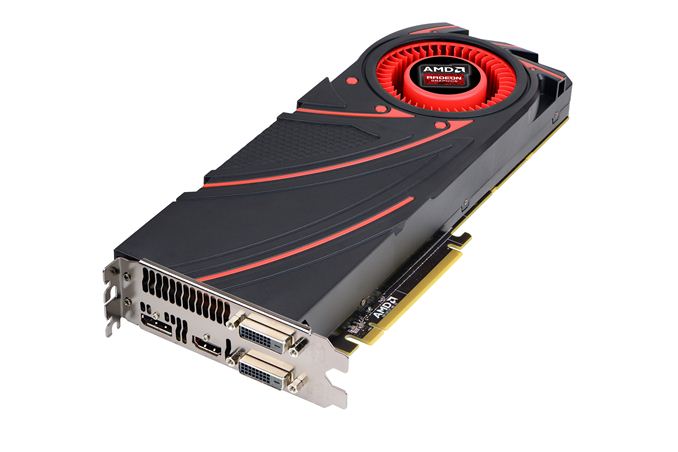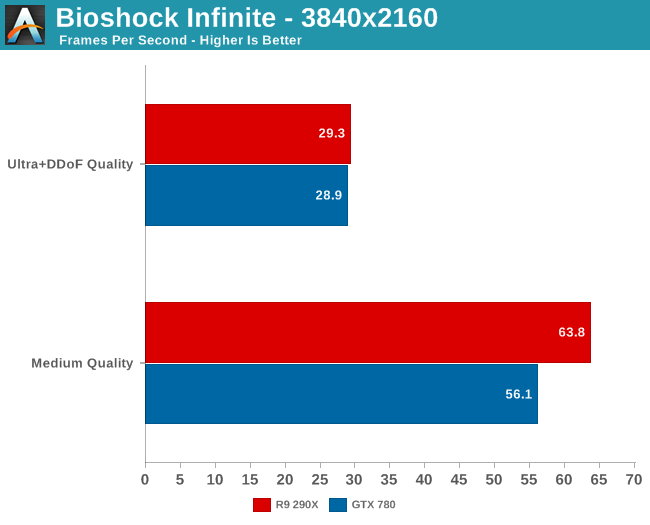AMD Radeon R9 290X Performance Preview: Bioshock Infinite
by Ryan Smith on October 17, 2013 3:00 PM EST- Posted in
- GPUs
- AMD
- Radeon
- Hawaii
- Radeon 200

As something of a counter-event to NVIDIA’s gaming showcase taking place in Montreal, Canada this week, AMD has organized an early, brief reveal of their forthcoming Radeon R9 290X video card. The card won’t be launching until sometime in the future, but for today we’re being allowed to confirm that we have the card and are being allowed to publish a single benchmark: Bioshock Infinite at 3840x2160 (4K).
AMD has purposely kept the public details on the R9 290X sparse so far, so we know little other than that it’s a larger GPU rated for 5 TFLOPS of compute performance, and paired with 4GB of memory for a total memory bandwidth of over 300GB/sec. Like most segments of the consumer electronics industry AMD has been gearing up for 3840x2160 (4K) displays, so the Radeon 290X is AMD’s flagship card geared towards gamers using 3840x2160 or 2560x1440 monitors.
Consequently AMD is seeking to draw attention to their 4K performance with today’s benchmark reveal. AMD named the game, the cards, and the resolution – Bioshock at 4K against the GTX 780 – so this is a very limited subset of our full results. And as with all controlled benchmark releases we’d advise not reading too much into any single benchmark here, as the relative performance of NVIDIA and AMD cards changes with the game being tested, at times rather wildly..

The biggest problem with 4K displays for at least the intermediate future, other than price of course, will be that you’re either going to need a lot of GPU power to drive them or will have to take a quality hit to achieve acceptable performance. Neither the R9 290X nor the GTX 780 are powerful enough to stay above 30fps on Bioshock with everything turned up. For that you will need to drop down to Medium quality, which gets performance past 30fps and up into the 60fps range. The fact that we’re even talking about playing a game at 60fps this high of a resolution – with 2.25 times as many pixels as 2560x1440 – is a big accomplishment right there, it’s just not one that will come without tradeoffs. For little-to-no compromise 4K gaming we’ll undoubtedly need to turn to multiple GPUs and Crossfire/SLI.
Moving on, it’s interesting to note in this case that both cards are essentially tied at Ultra quality, but when we dial down to medium the 290X takes a very decisive 14% lead. At the highest quality settings we should be shader/texture bound due to the significant use of shader effects on Bioshock’s highest quality settings, whereas at lower quality settings at least some of the bottleneck will shift to elements such as ROP throughput, memory bandwidth, and the geometry pipeline.
Wrapping this preview up, we’ll have more details on the 290X in the near future. AMD has made it clear that they are aiming high with their new flagship video card, so it will be interesting to see what they can pull off as we approach Tahiti/7970’s second birthday.













89 Comments
View All Comments
Will Robinson - Thursday, October 17, 2013 - link
I am glad all the NV fans are enjoying the pre launch rumors.Principle - Friday, October 18, 2013 - link
So no big deal your 780 got shown up, you are in the first stage of grieving.Roboyt0 - Thursday, October 17, 2013 - link
Why does everyone keep going back to the, likely, fake results from that Chinese site, specifically the temperatures! These are the first possibility of REAL numbers we have to work with. With plentiful actual results just around the corner.If in fact the 290X does best the 780 by a bit, and matches Titan performance occasionally, this is still a win for the AMD camp. The 780/Titan houses 1.1 Billion MORE transistors, +18%, on a die that is 25% larger; 551 mm^2 for 780/Titan compared to 438 mm^2 for the 290X. AMD is doing more with less. Let's do some simple math: Nvidia 780 GPU is 25% bigger, with 18% more transistors, and either has a miniscule lead or is losing...what happened? What would Nvidia be doing with a smaller die and transistor count? Not many of you green guys want to focus on this very important detail.
Also, the exaggeration of the information surrounding the 290X 'crushing' the Titan is obnoxious. To clarify, AMD said the 290X will perform much better than the Titan SPECIFICALLY in BF4 while using the Mantle API. If you think the Titan will beat the 290X under these SPECIFIC conditions, you are sadly mistaken. We won't know exactly how this will play out until Mantle is released...
http://attackofthefanboy.com/news/radeon-r9-290x-m...
" Devon Nekechuck says that the new card will compete with the Titan and GTX 780 straight away, but “with Battlefield 4 running with Mantel, the card will be able to ridicule the Titan in terms of performance.” Nekechuck clarified that he means that Battlefield 4 will run much faster with the R9 290X and Mantle than it will with Titan. "
At the moment we can only be certain of one thing...AMD has erupted the internet into a frenzy regarding their new hardware :D
P.S.
This post brought to you by someone currently running a GTX 670
http://www.3dmark.com/3dm11/7331088
6kle - Friday, October 18, 2013 - link
We were already told that this card will do well with high resolutions. It is obvious to me that AMD did some cherry picking by saying you can only test at 4k resolution. They probably also chose Bioshock for the same reason.In my opinion AnandTech should have said in this article that AMD was likely to choose the most flattering test enviroment for their card for this early benchmark release or simply not release this info because it's borderline free advertising for AMD instead of real benchmarking.
Principle - Friday, October 18, 2013 - link
They did not only test it at 4K, they could only release that data and comment about that.What makes you think Bioshock will be the most flattering for AMD?? How about pick one that HD7970 could keep up with the 780, like Grid 2. AMD didn't even beat the 770 before on BioShock.
DZtruthseek - Friday, October 18, 2013 - link
When you guys are able to, could you make a article with benchmarks of the R9 series in crossfire?? Or just post the 290X, 280X, and 270X crossfire benchmarks??wwwcd - Friday, October 18, 2013 - link
Windows 8.1 is a too new version. So we need or correct drivers for it.I think I deliberately tested with this version of the OS, and that this was done in favor of Nvidia, which have been prepared their drivers precisely such a testJames5mith - Friday, October 18, 2013 - link
Just need to get something off my chest...AA is not needed at that resolution in my opinion. Why would you try and use it?
Paullwar - Friday, October 18, 2013 - link
Firstly greetings from across the pond and yes ole blighty has been foggy and cold.Ryan, in you're honest opinion are we saying that the ref board is middle ground between titan and 780 on a subjective game review.
If so - as you cannot disclose pricing what was the power draw in comparison to 780. This I feel shouldn't go against AMD 'embargo' as they are openly asking Anandtech to review both boards.
For the record and IMO AMD are being more than a tad cheeky with this request.